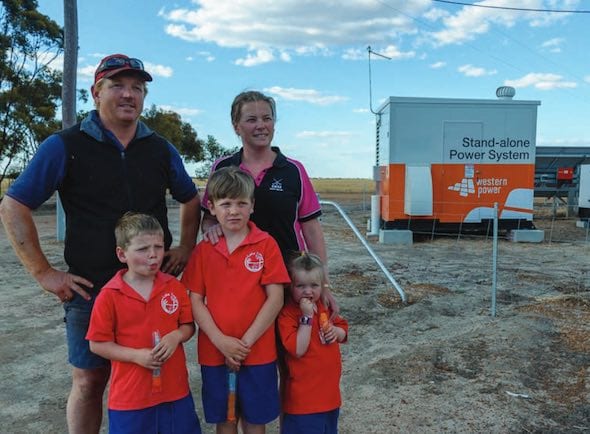
Western Australian utility Western Power has revealed the results of its stand-alone power system (SPS) pilot, confirming that the solar, diesel and battery storage systems deployed at six properties located around Ravensthorpe, Lake King and Ongerup, had delivered a 15-fold reliability improvement for customers.
In a report published on Tuesday, Western Power said the $4 million 12-month pilot – launched last July – had reduced the average time of outages for the six properties involved to less than five hours, with two properties recording no outages at all.

This means that the reliability of electricity supply to the fringe-of-grid customers – who remain connected to the grid, but have not been drawing any power from it – was lifted to almost on par with average metropolitan levels of 99.9 per cent, the report said.
By contrast, the grid-supplied community members in the surrounding Great Southern Region experienced average outages of almost 70 hours over the same period of time.
And while the power systems used in the pilot included a back-up diesel generator, the report shows that 92 per cent of the power needs of the customers were met by the solar and battery components of the system alone.
And according to the results of a July 2017 survey by Western Power, participants have preferred their SPS experience to their experience on the grid, with an overall satisfaction rating of 9.4/10 for supply.

But it is perhaps an even more important result for Western Power and other network operators, in that it means avoiding “hundreds of millions of dollars” that would otherwise be spent building more poles and wires and upgrading existing lines along Australia’s expansive and famously “stringy” grids.
Indeed, Western Power says it has identified more than 3,000 families and businesses that could benefit from its SPS technology.
“Early modelling shows that SPS could reduce network cost by more than $300 million, with the potential to save hundreds of millions of dollars as solar and batteries costs come down,” said the CEO of the government owned utility, Guy Chalkley.
But in a rather disappointing twist, Western Power cannot immediately pursue this opportunity, due to current network regulations drafted before alternative technologies were prevalent.
“We are already investigating the potential wider roll out of SPS, pending the resolution of statutory and regulatory barriers,” the report says.
“Some of these barriers define a battery as a generator, which we – as a network operator – are not permitted to be,” it says. “This technology was not contemplated when the electricity legislative framework was developed.
“Many ‘meshed’ or integrated networks around the world are evolving to become modular i.e. dynamically connected microgrids interacting with centralised electricity
networks,” the report says.
“We also consider islanded infrastructure solutions, such as SPS, to be another critical part of our network’s evolution.”
In the meantime, Western Power has committed to supplying the six properties used in the pilot via their SPS – the specifications of which are outlined in the table below – for a further three years, in the hope that regulatory certainty would green light their roll-out across the network.

“The pilot plays a critical role in helping to boost the case for legislative changes for the deployment of these systems, as part of improving electricity supply in regional areas,” the report says.
Last year, Western Power submitted a rule change request to the Australian Energy Market Commission asking that emerging technology solutions such as battery storage be reclassified as part of the network planner’s solutions toolset.
“We want to provide the service that’s in the best interest of our customers. As a utility it means supplying people with electricity in a way that’s safe, reliable and efficient,” said Chalkley.
This article was originally published on RenewEconomy’s sister site, One Step Off The Grid, which focuses on customer experience with distributed generation. To sign up to One Step’s free weekly newsletter, please click here.








